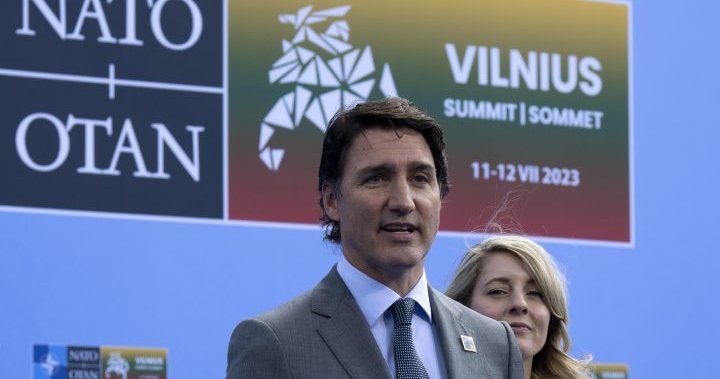NATO leaders have pledged to spend more on national defence, even as Canada and others are failing to meet the previous target.
A statement released this afternoon in Vilnius, Lithuania, says NATO members pledge to make two per cent of GDP the minimum spend each year, with one-fifth of that going to equipment.
The allies say they acknowledge that more is needed urgently to meet their commitments as members of the military alliance.
Only about a third of the 31 members are spending two per cent or more on defence.
Estonian Prime Minister Kaja Kallas says her message to allies is that the threat from Russia is real and that more is needed.
She and Prime Minister Justin Trudeau met earlier today, and she thanked him for Canada’s commitment to send more troops and more money to a NATO mission in Latvia.

Long-standing domestic issues are also playing a role in Canada’s global reputation, Carleton University professor Stephen Saideman said.
“They have not fixed the procurement processes,” he said.
“They have a personnel shortage. Together, those two things make it hard, just simply hard, to spend money. Even if you allocate a lot of money, the actual spending of it is hard.”

The changes expected at this year’s summit include new European defence plans and a defence production action plan, which Stoltenberg said earlier this week will “aggregate demand, boost capacity, and increase interoperability.”
Defence procurement processes in Canada are notoriously long and often fraught with controversy as domestic and foreign players compete for lucrative contracts.
“In some ways, there could be attractive solutions to Canada working with other allies in the development and procurement space. The problem we run into is that procurement is such an important part of domestic politics,” Sayle said.
Right now, Canadian company Bombardier is teaming up with General Dynamics in a bid to encourage the federal government to award them a contract to replace the aging Aurora surveillance aircraft fleet.

The government has insisted it is pursuing a competitive process, but it has taken steps to get approval from the United States State Department to purchase as many as 16 advanced P-8A Poseidon planes.
In a briefing before the NATO summit, senior government officials noted that the federal government has increased defence spending by 70 per cent since 2014. The officials provided a briefing to journalists under the condition of anonymity.
“It is certainly true this government has spent more money in the military. It’s certainly true it has tried to spend more money in the military,” Saideman said.
On Monday, Trudeau announced plans to spend $2.6 billion over three years to boost the Canadian presence on NATO’s eastern flank by growing a Canada-led multinational battle group in Latvia to a brigade by 2026.
His government has also pledged around $40 billion on Norad modernization, along with billions on purchasing F-35 fighter jets and building new naval ships. All of that will increase the amount the country spends.
Earlier this year, a Washington Post report cited leaked documents that said that Trudeau had privately told U.S. officials Canada would not meet the spending target.
“Part of that was a matter of being honest about our limitations, and part of it was this government’s priorities,” Saideman said.
“It doesn’t want to spend two per cent on the military, because that would mean either raising taxes or spending less money on something else.”
In a statement on Monday, Conservative party defence critic James Bezan and foreign-affairs critic Michael Chong argued that Canada’s role as a “trusted and reliable” partner has diminished.
“Our troops are struggling to do the jobs their country is asking of them due to personnel shortages and a lack of equipment,” the statement said.
“Prime Minister Trudeau has a chance at the Vilnius Summit to make a commitment to address this neglect.”
— With files from Dylan Robertson.
© 2023 The Canadian Press




